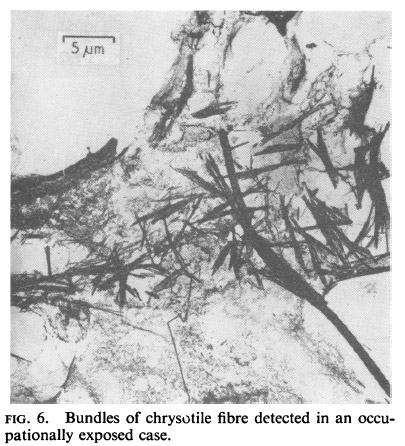- Home
- Deceptions
- Solar
- Thermal Audit
- Ventilation
- Sensors
- Governance
- Environment
- Reference
- Contact
- News
Respirable Fibers and the Asbestos Issue
Asbestos is a excellent insulator which occurs naturally and is cheap and abundant.
The problem is not asbestos per se, but that mining and manufacturing workers were not protected until recently by occupational and safety regulations and were subjected to enormous quantities of respirable fibers which lodged in their lungs and caused disease. Had it been carbon nano-tubes that they were working with, the result would have been the same. Below is an electron microscope image of some asbestos fibers found in human tissue. See the article Electron microscope characteristics of inhaled chrysotile asbestos fibre F. D. POOLEY Department of Mineral Exploitation, University College, Cardiff for more details.

The respirable fibers that cause the most problems are the microscopic variety that are small enough to be inhaled deeply into the lungs, having a length of <3.2 to <7 μm; diameter of <0.18 to <1 μm). A micrometer is a millionth of a meter, so they are far to small to see. There are many types of cells in lung tissue with up to a six fold variation in cell size, but in general they are approximately 10μm in diameter. In other words, these fibers are about the same size as the cells they interfere with.
Nobody knows for sure what the mechanism is that causes gene mutations, but when short, durable fibers get inside or attach to the surfaces of human cells, they interfere with the normal biochemistry of the cell and bad things happen -- like cancer. It could be the electrical charge on the fiber, or surface chemistry, or physical interference or a combination of all these things that cause havoc. The study The Strength of Disease: Molecular Bonds Between Asbestos and Human Cells , published Fall 2008, may be a breakthrough in this area.
I would postulate that any durable fiber with similar dimensions will cause similar problems including many of the asbestos replacements that we manufacture at enormous cost (as opposed to simply mining the stuff). So, I was definitely not surprised when I read the following:
"[c]ertain types of carbon nanotubes -- microscopic graphite cylinders used in a small, but growing, number of Space Age applications -- could pose a cancer risk similar to that of asbestos if inhaled," according to a study published online May 20 in the journal Nature Nanotechnology -- see this tissue pathology blog.
Or this from a WHO report "WHO Workshop on Mechanisms of Fibre Carcinogenesis and Assessment of Chrysotile Asbestos Substitutes 8-12 November 2005, Lyon, France". Document is here.
"para-Aramid releases respirable fibres with dimensions similar to known carcinogenic fibres. p-Aramid fibres have induced pulmonary effects in animal inhalation studies. Biopersistence was noted. The workshop considered the human health hazard to be medium." Recent research (2009) indicates that para-Aramid fibers do break down in the body and are eliminated and therefore of low risk.
We will never see the kind of evidence that we had with asbestos because never again will people be covered from head to toe with fibers, or will workers be dumping loads of fibers on co-worker's heads as a joke, or will workers at siding/shingles plants be going home looking like snowmen. When I was young I had a tour of an asbestos mine in Canada and was given a gift box of asbestos, with individual compartments for different grades of fiber.
Here is an article "Glass Wool (Respirable Size) Reasonably anticipated to be a human carcinogen".
It would also be unethical to purposely expose humans to see if the new fibers are just as bad as the asbestos they replaced. Nobody is going to do a clinical trial to see what happens when workers are covered from head to toe with modern fibers and breath them in by the trillions.
Our obsession with asbestos itself (as opposed to exposure to respirable particles in general when protective equipment is inadequate, unavailable or not practical) as something horrible is perpetuated by the industry that creates asbestos substitutes, the asbestos removal industry and the litigation industry. It is not in their financial interest to promote a wider understanding of respirable hazards or common sense. The litigation industry is truly enormous. Here is an article on litigation reform which states To date, over 600,000 people have filed claims and over 8,400 companies have been named as defendants. At least 60 companies have filed for bankruptcy as a result of asbestos liability. Estimates are as high as $200 billion with half of that being transaction costs, such as attorney fees and expenses.
The real problem was using products that release respirable particles in places where people are exposed to them (building insulation for example) and the lack of safety in mining and manufacturing -- not asbestos itself. Fortunately, ignorance of respirable hazards is behind us.
I am reminded of an incident I saw once where an old building was being taken down across the street from a public health laboratory, and a special crew with hazardous materials suits came in to remove some asbestos. Once they were gone, workers with no protection at all were removing pieces by hand. Standing beside me was a public health lab director -- who said "they are missing the point. That was the old sanatorium where the tuberculosis patients lived. There must be dormant TB all over the place. They are ones that should be taking precautions".
It seems to me that using these naturally occurring fibers with modern safety equipment during manufacturing and prohibiting their use in areas where humans could breath respirable dust, would have been the way to go.
If you came here looking for information on asbestos related diseases, please check out Pleural Mesothelioma Center and Mesothelioma Guide.
